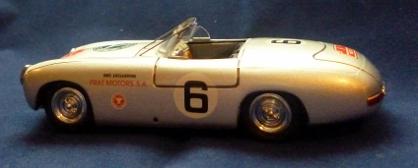
Mercedes 1952 W194 300sl
In the 1930's the German firms of Mercedes-Benz and Auto-Union dominated European Grand Prix racing and battled to set astonishing speed records, Mercedes taking the honours for the flying kilometer on the 28th of January, 1938. Rudolf Caracciola's record of 432.7 km/h (268.9mph) was set on a public road and as such still stands. Todays fastest production car, the Bugatti Veyron Super Sport, has only managed 267.85mph; and that on a oval track! During six seasons of racing Mercedes shattered seventeen speed records, won three Hill climbs, 14 Grand Prix and took an additional 21 GP podium places. Such a heritage can't be ignored; now, or in 1951. On the 15th of June, 1951, the Mercedes Board decided a return to motorsports would resurrect the companies former level of recognition and prominence. Recovery from the ravages of war might have been well underway but Daimler-Benz AG still had to keep a tight hold on the purse strings. F1 was out of the question because of the costs involved and the then lack of stability in the regulations. That left sports car racing as the obvious solution.
But; Daimler-Benz had nothing suitable to campaign in the 1950s, their latest car was the Type 300, a large, spacious, powerful and luxurious car; all the requirements to compete with Rolls-Royce but only one in four virtues of any use on a race track. Resolved to participate in motor racing the Management commissioned Rudolf Uhlenhaut to produce a '300 SL (Sport Leicht) Super-Light'. Saying sport-light-super-light is a bit unnecessary and the suffix soon became the now familiar SL, it also spawned a range idea that would be revived by the company several times in the future.
In 1950 Rudolf Uhlenhaut was actually head of passenger car testing at Mercedes but he must surely have been longing to get back to motor racing. In reviewing the Type 300 with his team he must have quickly come to the conclusion that converting this car was an impossibility, but that didn't mean some of the parts wouldn't come in useful. The stock 3Ltr, straight-6 engine was already good for 115hp, but big and heavy, especially when mated to the 4 speed gearbox of the type300. With some work both could make promising racing units. Such big items fitted nicely within the tall lines of the Type 300 body but the chassis weight and high body lines of the 300 rendered those useless for racing. Uhlenhaut needed an all new chassis; strong, rigid and above all light in weight. Over that a very light weight body with an aerodynamic shape would have to be created. The racing workshop at Stuttgart-Unterturkheim had their work cut out for them, or rather, they didn't! Almost everything would need to be engineered from scratch or modified from stock, it had to be made as reliable, and as cheaply, as possible.
Uhlenhaut knew he could make the car fast enough, if the rest of it was light. So, starting with the chassis an innovative, lightweight, design method was devised. He fell back on bicycle technology and created a series of triangles formed from very fine high-alloy steel tubes welded together to form a super lightweight spaceframe. It had exceptional torsional stiffness and astonishingly low weight; generally quoted as around 82kgs, or little more than an adult of the time, some people have claimed it weighed as little as 50kgs. As the chassis were all made by hand, and thus slightly differently, there is a small variation in the spaceframe weights.
Within this framework the team shoehorned the relatively massive power plant and gearbox, utilising some interesting changes and ideas to achieve this magicians feat. In creating the M194 engine they reduced the overall height of the engine by giving it dry sump lubrication and a new head, which also raised the compression ration to 8:1. Triple Solex bbl downdraft carburettors fed the mixture to the six-cylinder in-line engine via a single inclined overhead Inlet valve per cylinder operated by a single overhead camshaft; which also operated the single inclined overhead exhaust valve per cylinder. The camshaft was turned by a double roller chain driven off the crankshaft, which ran in 7 friction bearings with steel backings. The power output was raised from the stock 115hp to a more useful 170hp (125 kW), and with a little more tweaking, in the form of direct fuel injection by Bosch, squeezed to 175hp at 5200rpm. Uhlenhaut and his team had transformed the decidedly non-sporting Type 300 engine from the Adenauer sedan into a solid racing engine, but no one was under any illusion that 175hp was enough to guarantee results. The aerodynamics needed to be right too so this still rather tall, longitudinal mounted, unit was canted over at an angle of 50 degrees to the left. This lowered the centre of gravity as well as the frontal area, and would eventually lead to a new styling tone for Mercedes-Benz.
Power from the engine was fed through a single disc dry-plate clutch to the 4-speed manual gate change gearbox. A cardan shaft went to the rear diff' to drive the rear wheels. Gear ratios were changeable but the standard was 1st: 3.33; 2nd: 2.12; 3rd: 1.5; 4th: 1.0, which was enough for a final top speed of 240km/h. As for the rest of the chassis suspension was by double wishbone, coil springs, torsion bar stabilizer and telescopic shock absorbers at the front and Mercedes swing axle, coil springs and telescopic shock absorbers at the rear. Braking was hydraulically actuated shoes inside air-cooled light-alloy drums. Steering was of the recirculating-ball system. The 170Ltr fuel tank was set low in the back of the frame and fuel was pumped by two electric pumps.
For the team of engineers the chassis was the most important element of their new car and testing the innovations equally important. Rudolph Uhlenhaut was more than just the chief engineer he was a very capable driver and took his chassis out on the roads. In 1951 a rather ugly looking set of converted coupe body panels shrouded the spaceframe giving little indication of the engineering genius at work underneath. In a rare photo' of this 'mule' an unusual hole in the driver's side front between the grill and the headlight is the only giveaway to something different going on underneath. This is the air intake for the slanted engine's triple carb's. Once satisfied with the handling and general performance attention turned to the actual body shape design. First the material to make the body panels out of was considered and it turned out Mercedes could get a lot of aircraft metal that had been meant for the infamous Luftwaffe's Junkers bombers but was never used. This alloy of aluminium and magnesium would be ideal for a lightweight aerodynamic body to go over the delicate latticework of the lightweight chassis.
This new body needed to be as aerodynamic as possible, but when work began on the shape the team hit a snag with the high sided chassis. No space for traditional doors! To compensate they made deep cuts into the roof and made hatches from the top of the sides almost to the centreline and hinged at the top. Initially these little hatches were all that was considered necessary but later they were expanded down to the top of the frame which further enhanced the look of the now legendary “gullwing” doors, incidentally the French nicknamed the car 'Papillon' (Butterfly). Jean Bugatti had designed similar doors for the Bugatti type 46 in 1939 but as the rest world was embarking on the 2nd world war the care never made it to mass production, One can only wonder if Uhlenhaut got to hear of the design. On the Spider version the doors are hinged at the front and open up wards like scissor doors. Uhlenhaut and his team drew up the wind-cheating, bullet-like shape for the W194 300SL not dissimilar to Porsche 356 of 1948, a car also designed in Stuttgart. This was a groundbreaking body which had integrated headlights, arches just enough to accommodate wheel movement and a bonnet so low it only just cleared the air filter. In a design where form clearly follows function there is no trim at all and even external rear view mirrors were considered an unnecessary luxury.
This sleek body helped keep the centre of gravity low and resulted in amazingly low drag. Mercedes lack of a wind tunnel didn't hold the team back. It turns out they used the water tank at the University of Stuttgart and a small wooden model. Apparently there are records stating the car had a drag coefficient of 0.25 Cd, better than a Toyota Prius, but modern wind-tunnel tests produced a figure of 0.367. Perhaps that isn't up to the best modern standards but for 1951 it was still very good, as sleek as a Ferrari Testarossa for instance. Overall dimensions ended up as: Length 166.1”, Width 70.5” and Height 49.8”.
As an example of the weight issues consider the engine weight was 265kg; shedding pounds was a real priority so that in the end the rest of the car weighed 870kg. Were possible parts were made of aluminium or magnesium, if stock parts were used then they were drilled to save weight. even the glass is actually clear plastic. The interior was sparse, although for a race car very comfortable, panelled throughout with body hugging contoured bucket seats, upholstered in tartan wool cloth that would become another racing Mercedes hallmark, and perfectly positioned instrumentation. Many of these instruments came from war surplus aircraft parts. The Junghans clocks, which were prominently located in the centre of W194 dashboards, were originally bound for Junkers and Messerschmitts. In another sacrifice to the spaceframe the four-spoke steering wheel can be moved to make access to the car easier. The wheels were a compromise between strength made from sheet-steel discs with a centre mounting knock-off securing system. Front and rear tyres were 6.70 x 15 on a wheelbase 2400mm, front track is 1381mm and the rear is wider at 1445mm. All in all a dry weight of 2497 lb, 1132.62kg, was acceptable and in November, 1951, Mercedes undertook its initial tests at the Solitude circuit just outside Stuttgart, just nine months after the original decision to go racing was made. The performance might not sound astounding to us but 0-60mph in 7.0sec's isn't bad for 1952, nor is a quarter-mile time 15.0 sec's. Further testing was held at the Nürburgring and the Hockenheimring in the same month.
1952 Carrera Panamericana
November 1952 offered up the 3rd Carrera Panamericana in Mexico. Over 8 stages crammed into five days from the 23rd of the November the competitors would cover a gruelling 3111km, or 1933.021miles. The race was becoming one of the major sports car races of the season attracting the works teams of of not only Mercedes but Lincoln, Porsche, Volkswagen, Gordini and Alfa Romeo too. Ferrari's cars were run by the “private” Guastalla team who were granted three specially built Ferrari 340 Mexico Spyders and a 250S to be driven by Mille Miglia winner Giovanni Bracco.
For the first time the race organisers introduced a two class system so American heavy saloons would not have to race directly against much more agile European sports cars. Mercedes-Benz sent three cars, two coupes and a roadster, along with a highly organized group of people to drive and service the cars. The reputation of the 300 SL (the public name the fans knew the car by) had already spread and it was considered by many as a de facto victory machine, but The Carrera Panamericana was probably the most demanding race of the era were nothing could be taken for granted.
The Mercedes-Benz racing team would be the highly talented and experienced pairings of Hermann Lang and Erwin Grupp, Karl Kling and Hans Klenk with new young talent John Fitch and Eugen Geiger driving the 300 SL Roadster (W 194). Ferrari had won in 1951 and backed up Giovanni Bracco with three other top line drivers Alberto Ascari, Luigi Villoresi and Luigi Chinetti.
The Race
Starting from Tuxtla Gutiérrez, close to the Guatemalan border, the first stage ran through to Oaxaca. It would see 17 retirements, including Ascari’s Ferrari and a Gordini as well as a most extraordinary accident for Karl Kling and Hans Klenk. Travelling at almost 200 km/h (120mph) though a long right-hand bend Kling came across a concealed group of vultures, and, startled by the sound of the virtually un-silenced 300SL the flock took to the air. One of them struck the passenger side of the windscreen with such force that it came into the car and hit Klenk in the face, briefly knocking him out and leaving him bleeding badly from facial injuries; Klenk bravely instructed Kling to keep going at full speed. The pressure build up in the cabin resulted in the rear window popping out a few kilometers later so the conditions for poor Klenk must have been most dreadful. Nevertheless the two men raced on for almost 70km (43mi) more before they cleansed themselves, and the car, of bird, blood and glass when they were forced to stop to change a tyre. The species of the dead bird is said to be a Caracara, with a minimum wingspan of 115cm (45in) and weighing as much as 5 fattened geese! At service that evening the mechanics fitted new windscreens and also bolted eight vertical steel bars over the windscreen. These “buzzard bars” remain the cars most distinguishing feature to this day.
As for the standings Jean Behra’s lead in a Gordini by 6 minutes from Bracco’s Ferrari and despite all the problems Kling and Klenk held third place 8 minutes behind the leader.
Day two would consisted of two legs with an hour break in between. The first was to Puebla and is remembered for Jean Behra's awful crash, his Gordini left the road and tumbled down a ravine. Miraculously Behra survived but his car was wrecked. Bracco assumed the lead in his Ferrari but it was Villoresi's Ferrari that won stage 2 from Fitch and then Kling. After the hours rest leg three started the run down to Mexico City. This was also won by Villoresi but not by enough to put him on top of the overall classification. At the end of the day, Bracco still held the lead but now the three Mercedes had moved up so that Kling was now 2nd followed by Fitch 3rd and Lang 4th.
Another 2 stage day came on day three. Leg 4 to León had long straight sections that favoured the powerful Ferraris and Bracco kept his lead although Villoresi once again won stage ahead of Chinetti and the three Mercedes cars. This was followed by the longest leg of the race, over 530km, to Durango. The roads were starting to suit the nimble Mercedes now and Karl Kling set fastest time in his 300SL in front of Bracco’s Ferrari, closing the overall time gap on him.
Day four brought two more stages, but the Mercedes progress continued and Kling was getting very close to Bracco. The Ferrari was on it's last legs and just prior to the start of leg 7, in Parral, Bracco made one of the greatest sporting gestures in motor sports. Knowing his cars condition was terminal, and that this race was probably the most dangerous of them all, he approached Kling and explained that he did not need to take unnecessary risks as the Ferrari was about to give up. Just a few miles into the stage the Ferrari did indeed expire and Kling took over the lead, But the other Mercedes cars were in trouble. Lang's car shed half a door costing him time and Fitch had been disqualified, some sources say for reversing in the pits after stage 7 while others report he had outside assistance to repair his car.
The final leg from Chihuahua to Ciudad Juárez was the only one on the last day and Kling completed the 370km in 1h 44mins. His race might have started with the 'bird' incident and a gruesome drive to the end of the first stage but Kling and Klenk were now victorious ahead of Lang and Grupp; Luigi Chinetti was third in a Ferrari. The winning time was 18:51:19, giving an average speed of 165.011kph, and would have been a Mercedes 1-2-3 but for the technical infringement that caused Fitch's disqualification.
This classic Mercedes victory ranks as one of the brand’s most spectacular successes but is probably down to the innovative use of pre-prepared 'pace-notes'. Klenk could keep Kling informed of the upcoming bends and road conditions in the now accepted role of the rally navigator. It is also a similar system that used by 'Jenks' when he guided Moss the that famous Mille Miglia win in 1955, also for Mercedes.
Legacy of the W194 race car.
A derivative of the ‘ordinary' Mercedes 300 series the 300SL was far from ordinary. Unable to do what other racing teams did and completely engineered the cars from the ground up Mercedes used many off-the-shelf parts in the 300SL making the extraordinary winning streak even more impressive. A masterpiece of intelligent design the 300SL gave the driver with more comfort than any other contemporary sports racing care and was still enough of a real car to provide a luggage compartment was worthy of the name; a space big enough to carry two spare wheels during the Carrera Panamericana.
It is without doubt the vehicle which re-established Mercedes-Benz as a formidable power in motor racing, encouraged the company to push to return to Grand Prix racing in the new F1. Thanks to the a development of the same engine and canted over in much the same way as the 300SL. Using a similar swing axle design at the rear and many other parts and systems tried and tested on the 300SL for two seasons in F1 Mercedes W196 racers carried all before them. They also spawned the 300SLR that dominated sports car racing in 1954 and 1955 too.
Ten 300SL race cars were built for 1952 and an 11th car joined them in 1953 although it never actually raced. Eight still survive but amongst those lost chassis' is the first car, chassis W194/1. Against the more powerful Ferraris and Porsches, it was not only the innovative design but the rugged reliability of the W194 300SL's in 1952 that took them to victory. Uhlenhaut himself remarked on the issue of reliability :-
"The races run in 1952 have shown that the 300SL with a naturally aspirated engine was at least equal -- if not superior -- to even the strongest opponent. However, the opponents' inferior operational reliability and the great endurance of the 300SL generally led to victory for our brand."
300SL Gullwing
The 300SL legend might have died after these racing success were it not for the vision of one marketer in the United States. New York City newspapers carried the news of Mercedes' victories and came to rest on the desks of several interested parties. One of these was the recently appointed Daimler Benz U.S. importer Max Hoffman. He was a shrewd businessman who had no design training but he had an idea that would eventually cement his place in auto design history. He spent two years convincing Mercedes that the U.S. market was ripe for a sports car like the 300SL racers. In 1954 the iconic W 198 300SL 'Gullwing' Coupé was put on sale. Clearly based on the W194's design the style concept opened a new chapter for Mercedes-Benz vehicles expressing the marque's ability to reach deep in the realms of design and innovation. It became the dream sports car of the 1950s, ending with the exotic 300SL of 1963, a very fast convertible for the rich and famous.
The 300SL had such an impact on car enthusiasts worldwide that over the past six decades there has always been an 'SL' model in the Mercedes range. To prove the point the design was awarded the accolade 'Sports car of the century' in 1999. The rest is automotive history; history that probably wouldn't have been had Rudolph Uhlenhaut's W194 not been the success story it was.





1/43rd scale kit.
Built by Ian.



NewRay are a Chinese company that produce a wide range of toys and diecast models. The 'kit' range isn't that big but does include many interesting subjects. They are very reasonable priced (as of 2014) and come with a pre-painted and pre-decaled body of acceptable finish. They are not the most detailed kits in the world nor are they totally accurate but they do allow the modeller scope to improve the basic kit and to detail as they wish.
This model was built in August 2014 almoat straight from the box. All the parts have been painted with a base coat of Alclad II black primer then the body interior parts and chassis underside were sprayed with Alclad II white aluminium. Citadel Acryillic inks and paits were used for all the detail painting. The seat material pattern was built up of multiple layers of decal stripe cut from old decals and covered with matt varnish.
Alterations to the kit were needed starting with the cutting down and re-shaping of the front windscreen, which was far to high for the actual race version. Small door screen also had to be scratch built from clear acetate sheet. A feature of the John Fitch car is the additional aero screen, this was built up from fine wire and spare clear acetate sheet; with a little piece of printers lytho' plate to make the actual frame. One other addition was the black pinstripe edging to the white identification flashes, for some reason these were omitted from the model by the manufacturer.
RETURN TO :-

